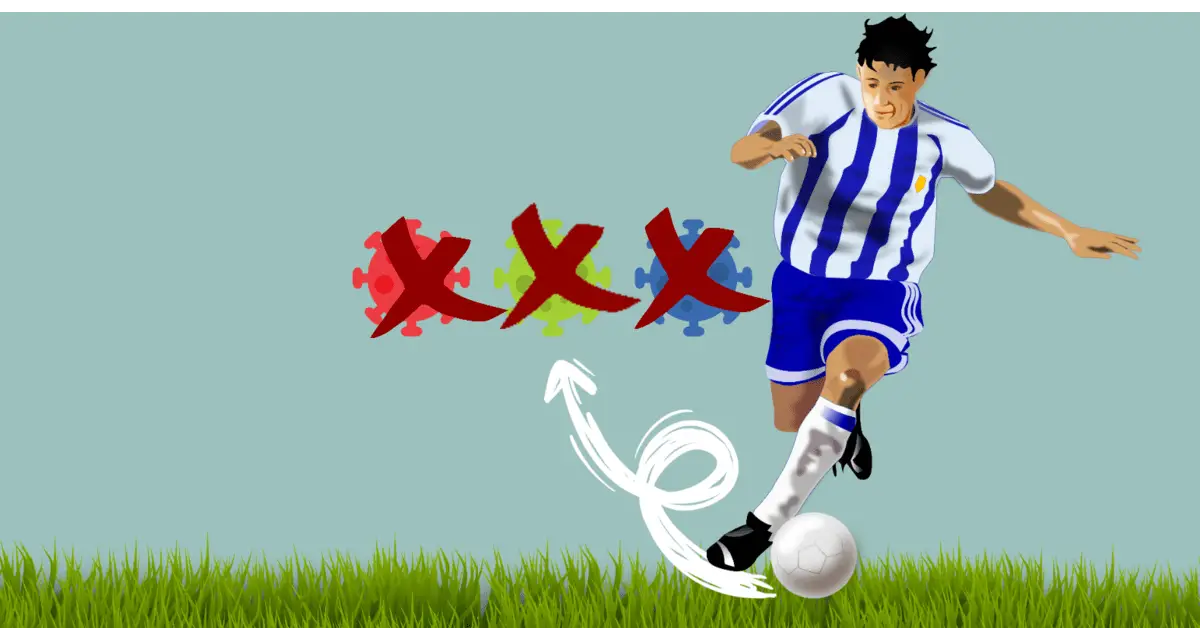High Press Tactic in Football is a popular and effective strategy many top football teams use in modern times. This tactic involves putting pressure on the opposing team’s players and forcing them to make mistakes or lose possession of the ball. In this analysis, we will look in-depth at the high press tactic in football.
In addition, High press is an aggressive and proactive approach to defending that aims to win the ball back high up the pitch.
This tactic involves pressing the opposition players when they receive the ball and denying them space and time to make decisions.
The high press tactic has become increasingly popular in modern football because it allows teams to control the game, create scoring opportunities, and limit opponents’ chances.
This analysis aims to provide an in-depth understanding of the high press tactic in football. We will explore the basics of pressing, different types, and the advantages and disadvantages of high press tactics.
Furthermore, we will discuss high press tactics strategies, implementation, successful examples, and common mistakes to avoid.
By the end of this analysis, you will have a comprehensive understanding of high press tactics in football and how football teams can effectively use them.
The History of High Press Tactic
The high press tactic has been used in football for several decades, but its popularity has recently increased.
While the exact origin of high press football is unclear, it is believed to have been first used by Austrian coach Ernst Happel in the 1970s.
Happel’s Dutch team, Club Brugge, used an aggressive pressing approach that helped them reach the European Cup final in 1978.
Several coaches have developed and refined the high press tactic over the years. In the 1990s, Arrigo Sacchi’s AC Milan team used a high press approach based on the concept of “pressing in a block.”
Later, Pep Guardiola’s Barcelona team used a high press tactic that focused on winning the ball back in the opposition’s half, leading to the famous phrase “six seconds or less.”
Jurgen Klopp’s Borussia Dortmund team and Liverpool FC have also recently popularized the high press tactic, using it to great effect in the Bundesliga and Premier League.
Types of Pressing in Football
Pressing is a defensive strategy that aims to disrupt the opposition’s possession and regain the ball.
Teams can use different types of pressing tactics, depending on their style of play and the opponent’s strengths and weaknesses. Here are some common types of pressing in football:
High Press
As the name suggests, high press involves pressing the opposition players high up the pitch. This tactic aims to win the ball back quickly and close to the opposition’s goal, giving the pressing team an excellent chance to score.
Mid-Block Press
Mid-block press is a strategy that involves pressing the opposition players in the midfield area. This tactic aims to restrict the opposition’s progress towards the pressing team’s goal and force them to make mistakes.
Low Block Press
Low block press involves pressing the opposition players in the defensive third of the pitch. This tactic is often used by teams defending a lead who want to limit the opposition’s scoring chances.
Trigger Press
Trigger press is a specific type of pressing that involves pressing the opposition player when they receive the ball in a particular area or situation. For example, a team may trigger pressing when the opposition defender gets the ball near the touchline or when the opposition goalkeeper plays a short pass.
Gegenpressing
Gegenpressing is a high-intensity pressing tactic that involves pressing the opposition players immediately after losing possession. This tactic aims to regain possession quickly and prevent the opposition from launching a counter-attack.
Each pressing requires different skills, coordination, and tactical awareness from the pressing team.
However, it is important to mention that we will focus on only High Press in this article.
High Press Tactic Strategies
While the high press tactic can be effective, it requires a well-planned and coordinated approach. Here are some strategies for implementing the high press tactic:
- Identifying the Right Moment to Press: The high press tactic requires the pressing team to identify the right moment to press the opposition. This can be when the opposition is in possession but has their back to the goal or when they are trying to play out from the back.
- Choosing the Right Area to Press: The pressing team should choose the right area to press, depending on their tactical approach and the opposition’s weaknesses. For example, they can press the opposition high up the pitch, in the middle of the pitch, or their defensive third.
- Pressing Triggers: The pressing team should also identify pressing triggers, which are specific events or actions that signal the start of the high press. For example, the pressing trigger could be when the opposition goalkeeper receives the ball or when a certain opposition player receives the ball.
- How to Counter-Press: Counter-pressing is an essential part of the high press tactic, which involves immediately pressing the opposition after losing the ball. This can prevent the opposition from building momentum and quickly win the ball back for the pressing team. The pressing team should be prepared to counter-press and should have a clear plan for doing so.
How To Implement High Press Tactic
To successfully implement the high press tactic, teams must have a clear plan and execute it precisely. Here are some key factors to consider when implementing the high press tactic:
- Identifying the Right Players for High Press: The high press tactic requires physically fit players to have high stamina levels and excellent pressing skills. Teams must identify the right players to execute the high press tactic effectively.
- Team Shape and Formation for High Press: The high press tactic requires a specific team shape and formation that can facilitate effective pressing movements. Teams must choose a formation that can provide defensive stability while allowing quick and coordinated pressing movements.
- Coordinating Pressing Movements: The high press tactic requires coordinated pressing movements from the whole team. Teams must work on their pressing movements in training and ensure that every player understands their role in the high press system.
- Balancing High Press with Other Tactics: The high press tactic is not standalone and must be balanced with other tactical approaches. Teams must be able to switch between high press and other tactics, depending on the opposition and match situation.
Successful Examples of High Pressing Football Teams
Several successful football teams have used the high press tactic in recent years. Here are three examples of teams that have used the high press tactic effectively:
Liverpool FC’s High Press under Klopp
Jurgen Klopp’s Liverpool FC has become one of the most successful teams in Europe by implementing a high press tactic. Liverpool’s high press is characterized by their aggressive and coordinated pressing movements, which are led by players such as Sadio Mane and Roberto Firmino. In recent years, the team’s attacking style and pressing tactics have helped them win the Premier League, Champions League, and other major trophies.
Manchester City’s High Press under Guardiola
Pep Guardiola‘s Manchester City has also implemented a high press tactic, which has helped them dominate the Premier League in recent years. Manchester City’s high press is characterized by their high defensive line and intense pressing movements, which are led by players such as Raheem Sterling and Kevin De Bruyne. The team’s fluid attacking play and pressing tactics have helped them win several Premier League titles and other major trophies.
RB Leipzig’s High Press under Nagelsmann
Thanks to their high press tactic, Julian Nagelsmann’s RB Leipzig has emerged as one of the most exciting teams in Europe. RB Leipzig’s high press is characterized by their intense pressing movements, which are led by players such as Marcel Sabitzer and Dani Olmo. The team’s attacking style of play and pressing tactics have helped them compete with some of the biggest teams in Europe, reaching the semi-finals of the Champions League in the 2019/20 season.
High Press Drills
See below an example of High Press Drills.
Advantages of High Press
This tactic has become increasingly popular in modern football because of its numerous advantages, including:
Creating Scoring Opportunities
The high press tactic can lead to quick turnovers and counter-attacks, creating scoring opportunities for the pressing team. By winning the ball high up the pitch, teams can capitalize on the opposition’s defensive weaknesses and score goals.
Controlling the Game
High press can help teams control the game by limiting the opposition’s possession and dictating the game’s pace. This tactic can force the opposition to make mistakes, leading to turnovers and scoring opportunities for the pressing team.
Reducing Defensive Burden
By winning the ball back high up the pitch, the high press tactic can reduce the defensive burden on the team. This tactic can prevent the opposition from building momentum and attacking the pressing team’s defensive third.
Boosting Team Morale
The high press tactic requires high intensity and teamwork from the pressing team. Successful implementation of this tactic can boost team morale and provide a psychological advantage over the opposition.
Putting Pressure on the Opposition
The high press tactic can put immense pressure on the opposition players, forcing them to make mistakes and lose possession of the ball. This can lead to frustration and mental fatigue, reducing the opposition’s performance levels.
Disadvantages of High Press Tactic
While the high press tactic can be highly effective, it also has several disadvantages that teams must be aware of. Here are some of the drawbacks of using the high press tactic:
Physically Demanding
The high press tactic requires a high level of physical fitness and endurance from the pressing team. This tactic involves a lot of running and sprinting, which can be exhausting and increase the risk of injuries.
Risk of Getting Caught Out
The high press tactic involves pressing the opposition high up the pitch, leaving spaces behind that the opposition can exploit with long balls or quick counter-attacks. If the pressing team is not coordinated or makes a mistake, they can get caught out and concede goals.
Vulnerable to Skilled Opposition
The high press tactic can be less effective against skilled opposition who are comfortable on the ball and can pass their way out of pressure. Against such opposition, the high press tactic can leave gaps in the pressing team’s defence, leading to conceding goals.
Requires Tactical Discipline
The high press tactic requires a high level of tactical discipline from the pressing team. If individual players break the pressing structure or fail to press at the right time, the whole system can collapse, leaving spaces for the opposition to exploit.
Mental Fatigue
The high press tactic requires a high concentration level and mental alertness from the pressing team. Players who become fatigued or lose focus can make mistakes, leading to turnovers and conceding goals.
Common Mistakes in High Press Tactic
While the high press tactic can be highly effective, it is also challenging to execute, and teams can make several mistakes while implementing it. Here are three common mistakes teams make while using the high press tactic:
- Overcommitting to Pressing: One of the most common mistakes teams make while using the high press tactic is overcommitting to pressing. If players press too aggressively or without coordination, they can leave gaps in their defence that opponents can exploit. Teams must balance pressing high and maintaining a solid defensive shape.
- Poor Defensive Transitions: Poor defensive transitions are another common mistake teams make while using the high press tactic. If teams lose possession after committing too many players forward to press, they can be vulnerable to counterattacks. Teams must ensure that they have players who can quickly transition from attacking to defensive positions to avoid conceding goals.
- Not Adapting to Opponents’ Tactics: Finally, teams may fail to adapt their high press tactics to their opponent’s tactics. Different teams use different strategies, and some teams may be more vulnerable to specific pressing approaches than others. Teams must be prepared to adjust their pressing tactics according to their opposition.
Conclusion
We have seen that the high press tactic requires a coordinated effort from the entire team and can be highly effective in winning back possession, creating scoring opportunities, and disrupting opponents’ attacks. However, it can also be risky if not executed properly, and teams must be aware of the common mistakes that can arise while implementing it.
Looking ahead, the high press tactic will likely continue to be an important strategy in modern football. With the increasing emphasis on pressing and high-intensity play, teams that can execute the high press tactic well will have a significant advantage on the pitch.
Further Reading:





